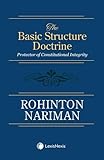The basic structure doctrine : Protector of constitutional integrity / By Rohinton Nariman
Publication details: Haryana LexisNexis India 2025Description: xxiv, 384 pages 25 cmISBN:- 9789349015661 (Hardback)
- 342.5402
| Item type | Current library | Shelving location | Call number | Materials specified | Status | Notes | Barcode | |
|---|---|---|---|---|---|---|---|---|
 BOOKs
BOOKs
|
National Law School | General Stacks | 342.5402 NAR (Browse shelf(Opens below)) | HB | Available | Recommended by Prof. Dr. Sanjay Jain | 40161 |
Browsing National Law School shelves,Shelving location: General Stacks Close shelf browser (Hides shelf browser)

|

|

|

|

|

|

|
||
| 342.5402 MAH - 3 Constitutional Law of India / | 342.5402 MAL Reclaiming the vision : Challenges of Indian constitutional law and governance | 342.5402 MIC Constitutional Essentials : On The Constitutional Theory of Political Liberalism / | 342.5402 NAR The basic structure doctrine : Protector of constitutional integrity / | 342.5402 NAR-1 India's Undeclared Emergency : | 342.5402 NAR-2 India's Undeclared Emergency : | 342.5402 PAL-II India Constitution : |
Dedication;
Preface;
Acknowledgments;
Table of Cases;
Chapters:
Chapter 1 - Historical Background to the Framing of India's Constitution;
Chapter 2 - The Gathering Storm: The First Amendment to the Constitution of India and Sankari Prasad's Case;
Chapter 3 - Basic Structure Born: Sajan Singh: Golak Nath; The Constitution 24th & 25th Amendments, 1971; and Kesavananda Bharati's Case;
Chapter 4 - The Judgment in Indira Gandhi's Case: HM Seervai Changes his Mind and Supports Basic Structure;
Chapter 5 - Weighed in the Scales: Pros and Cons;
Chapter 6 - The Conflicting Views of Constitution Benches in Minerva Mills, Waman Rao, and Bhim Singhji;
Chapter 7 - The Attempt to Clarify the Law by a Nine Judge Bench in IR Coelho's Case;
Chapter 8 - Later Judgments which have Applied the Basic Structure Doctrine
Chapter 9 - India Shows the Way to the Rest of the World;
Conclusion;
Appendix - Fundamental Rights Case by NA Palkhivala;
Subject Index.
This book explores the evolution of India’s Constitution, focusing on the development and significance of the Basic Structure Doctrine. It argues that the doctrine is pro the diverse people of India, safeguarding their interests rather than being anti-people. By restraining absolute power, the doctrine prevents corruption within government organs. The author meticulously interprets Article 368, which deals with constitutional amendments, harmonizing it with all other constitutional provisions. The book underscores that the interpretation of the Constitution is exclusively within the Judiciary’s purview. Through this judicial lens, the book demonstrates that the Basic Structure Doctrine is a vital interpretation ensuring the integrity and stability of India’s constitutional framework.
Key Features:
Examines key amendments, landmark cases, and judicial perspectives that have shaped constitutional law in India
Highlights India’s role in setting a global precedent for constitutional integrity
Provides a balanced view of the impact of the Basic Structure Doctrine on the nation’s legal framework
Weighs the pros and cons of applying the doctrine, with reference to the majority and minority judgments in Kesavananda Bharati’s case
There are no comments on this title.
